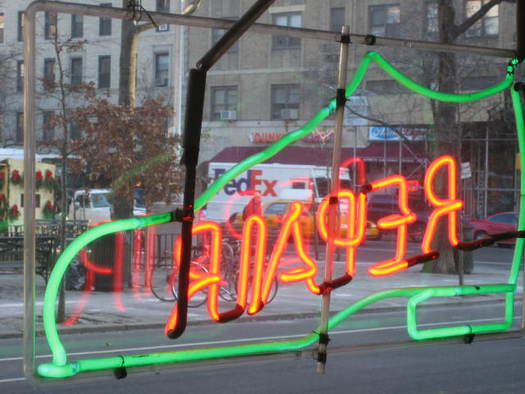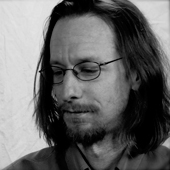
A. Fontana Shoe Repair in 2007, via Jeremiah’s Vanishing New York; today it exists only in dreams.
What does the city of your dreams look like? I don’t mean “your dreams” in the utopian, portfoliopolis sense, I mean the buildings and structures in your actual dreams. How fantastic or mundane do they appear? Which ones come from memory and which are invented?
As a regular reader of the blog Jeremiah’s Vanishing New York, I was interested when, in May, its proprietor (who calls himself Jeremiah Moss, apparently not his real name) announced a new side project: “Against my better judgment, I have started another blog: ‘Dreams of the Vanishing New York.’”
“I had noticed that many readers of this blog were reporting dreams about the lost city,” Moss wrote. “In emails, comments, and Facebook messages, these dreams kept floating in.” He’d had such dreams, too. He wrote some down, posted them on this new blog, and ask others to share theirs, hoping to end up with “a view into the city's collective unconscious.” There are some back-dated posts from Moss and some of his readers, presumably reflecting when the dream occurred.
I love this idea for any city, but maybe for New York in particular. I lived there for a number of years, and coming from the hinterlands it often struck me as a dream-like environment. Now I’m back just often to feel I know the place perfectly well, and to rediscover, constantly, that my memory is off. For one thing, significant parts of my New York have in fact vanished. But other details I simply recall incorrectly, or get confused about. I’m often certain there’s a subway station on this corner, or that thus-and-so restaurant is just a block away, but no: As in a dream, things aren’t where they should be. Meanwhile other city elements — multistory buildings, improbable chain retailers — seem to have emerged out of nowhere. (I’m constantly trying to remember: What used to be on this site?) So it’s still dream-like to me, but in a way that suggests instability.
Anyway, apart from a writeup in The New York Observer, the project hasn’t gotten much attention, which is too bad because it’s an idea that depends on submissions. (See below.) Still, the entries so far suggest interesting possibilities. A few actually concern the reappearance of vanished businesses and structures, but others dream-speculate about what might happen next. An anonymous contributor dreams of the Chelsea Hotel being bombed, and E.V. Grieve dreams of a well-known mural of Joe Strummer being replaced with one of Ronnie Wood. (“I think loss is a big anxiety in most people’s dreams,” Moss told The Observer. “Maybe in New York, we’re choosing things like the Chelsea Hotel to symbolize that when we’re sleeping.”) Moss offers a brief but hilarious example of dream gentrification: a store called Ralph Lauren: Pine pops up in the East Village, evidently aimed at the “urban lumberjack” demo. The most recent contribution is from Josh Alan Friedman, who adds to the dream version of New York by describing recurring dreams about wandering the near-ruins of a north Brooklyn amusement park “that once rivaled Coney Island — but apparently never existed.”
The effort may remind some of Sheila Heti’s project from a while back: I Dream of Barack and several other blogs made up of accounts of dreams involving various politicians, submitted by readers. I was a fan of that effort, but I like the notion of stories mapping a dream space — a space where the unbuilt (as in demolished) environment of a real city persists, right alongside what's there now, and what has never been.
Another reference point might be the movie Inception, although as Christopher Hawthorne memorably argued, its dream-environment architecture turned out to be surprisingly disappointing. Which makes me slightly hesitant to say that I sometimes wish I could see some of what’s described on Dreams of the Vanishing New York. What might the remnants of Friedman’s imaginary Joe E. Brown Grounds — or for that matter Moss's Ralph Lauren: Pine store — look like? How might an un-vanished A. Fontana Shoe Repair look today? Possibly because my favorite unreal city is the one where Julius Knipl worked as a real estate photographer, I imagine my answers in comics form.
Meanwhile, I keep trying to have an appropriate dream to submit, but it’s not working. If you have one:
“Send your vanishing New York dreams to jeremoss [at] yahoo [dot] com. Please include plenty of detail, along with any name (or Anon) you might want to be credited by.”


Comments [2]
I do not remember the A. Fontana Shoe Repair in the East Village, yet it must have been there near the Tanager Gallery (1952 -1962) on East 10th Street, where some of my favorite teachers got their start. I do remember the 1980’s East Village like the back of my hand and to remember it is like a dream. My girl friend (now my wife) would walk art critic/cooper union professor Dore Ashton’s DOG for her when she was away from home in the village. Here is a memory from Dore Ashton that I found on a quick search.
“The first co-operative artists’ gallery that I knew well was opened very near my home. It was called the Tanager Gallery on East 10th Street. It was a parlor floor in an old brownstone with a large window. I can remember the openings there: Every downtown artist packed into its limited space. One spring I remember seeing two Bowery bums staring at the colorful scene across the street and one bum said to the other: “Well, it takes all kinds to make a world.” Soon after, there was a downtown rush to open co-op galleries, and we all heartily supported them. It was, in its way, a political statement of defiance of commercialism and institutionalism in the rapidly expanding milieu of what is ludicrously called “The Art World.” To my mind, there is no such thing. The so-called art world is merely a small precinct in the great world, reflecting all its vices and, once in a while, its virtues. ” — Dore Ashton
2010_BMG_Catalogue.pdf
08.22.12
04:40
08.25.12
12:17